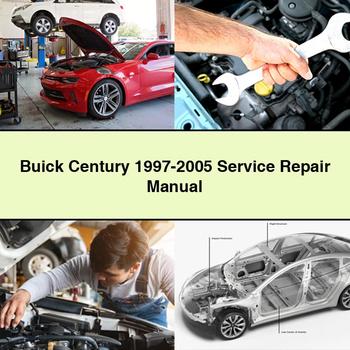Generation:
Third Generation (GM W-body)
Applicable Years:
1997, 1998, 1999, 2000, 2001, 2002, 2003, 2004, 2005
Vehicle Segment:
Mid-size sedan, focused on comfort and value for American consumers.
Competitors:
Ford Taurus, Chevrolet Lumina, Toyota Camry, Honda Accord, Nissan Altima.
Manual Advantage:
Provides dealer-level service information for the DIY mechanic or experienced technician, offering significant cost savings over dealership repairs. Comprehensive coverage, detailed illustrations, and clear, numbered instructions.
Vehicle Appeal:
Praised for its comfortable ride, spacious interior, and generally reliable performance for its class and price point. A practical, everyday vehicle.
Engine:
Engine mechanical, engine control system, lubrication, cooling system, fuel system, intake, exhaust, emissions control
Transmission:
Automatic transmission, manual transmission, clutch, drivetrain (transfer, propeller shaft, drive shaft, differential, axle, suspension)
Brakes:
Brake control system, hydraulic brakes, parking brake
Steering:
Steering column, power steering
Electrical:
Ignition, starting, charging, electrical system diagnostics, wiring diagrams, multiplex/CAN communication, horn, lighting
Body Interior:
Exterior and interior components, doors, windows, mirrors, windshield, glass, instrument panel, seats, engine hood, door locks
Comfort Convenience:
Air conditioning, cruise control, wiper & washer system, meters, audio/visual systems
Safety Restraint:
Supplemental restraint system (airbags), seat belts, engine immobilizer
Maintenance:
Routine maintenance, fluid changes, filter replacements, inspections
Diagnostics:
Troubleshooting common problems, diagnostic procedures, electrical system diagnosis
Repair Rebuild:
Complete disassembly and reassembly of components, engine rebuilding, transmission repair, brake system overhaul, suspension work
Electrical Wiring:
Detailed wiring diagrams, component location for electrical systems, troubleshooting electrical faults
Specifications:
Torque specifications, fluid capacities, component data, technical specifications for all systems
Depth:
Comprehensive: From basic do-it-yourself maintenance to in-depth professional repair and diagnostics. Includes step-by-step instructions based on complete disassembly.
Compatibility:
All PC-based Windows operating systems, Mac, Linux
Printability:
All pages are printable
Binding:
Not applicable (digital download)
Paper:
Not applicable (digital download)
Delivery Method:
Instant High Speed Download
Software Requirements:
WinZip, Adobe PDF Reader
Engine Code:
3100 (Series II) V6 (L82)
Displacement:
3.1 Liters (189 cubic inches)
Configuration:
V6, overhead valves (OHV)
Bore X Stroke:
3.50 in x 3.27 in (88.9 mm x 83.0 mm)
Horsepower:
Approximately 175 hp @ 5200 RPM (varies slightly by year)
Torque:
Approximately 195 lb-ft @ 4000 RPM (varies slightly by year)
Fuel Delivery:
Sequential Port Fuel Injection (SFI)
Recommended Fuel:
87 Octane Unleaded Gasoline
Emission Control:
Three-way catalytic converter, EGR system, PCV system.
Type:
4-speed Automatic (4T60-E, later 4T65-E)
Type:
None offered in this generation
Features:
Lock-up torque converter, electronic controls, overdrive gear
Automatic Transmission Fluid Type:
Dexron III (or equivalent specified by GM)
Length:
Approximately 195.3 inches (4961 mm)
Width:
Approximately 70.9 inches (1801 mm)
Height:
Approximately 55.8 inches (1417 mm)
Wheelbase:
Approximately 109.0 inches (2769 mm)
Curb Weight:
Approximately 3100 - 3300 lbs (1406 - 1497 kg), varies by trim and options
NHTSA Frontal Impact:
Good (for driver and front passenger, in most tests, varies by year)
NHTSA Side Impact:
Acceptable to Good (for front passenger, varies by year)
Active Safety:
Anti-lock Braking System (ABS) standard on most trims, Traction Control (optional on some models)
Passive Safety:
Frontal airbags (driver and passenger), side-impact airbags (optional on later models), front and rear crumple zones, side-impact door beams.
Audio System:
AM/FM stereo radio with cassette player and CD player (optional on some trims). Available premium sound systems.
Climate Control:
Manual or automatic climate control systems available depending on trim level.
Cruise Control:
Standard on most models
Traction Control:
Optional on some higher trim levels.
Connectivity Features:
Limited by era; typically no integrated Bluetooth or advanced connectivity features. May have OnStar preparedness on later models.
Oil Change Interval:
Every 3,000 - 5,000 miles or 3-6 months (depending on oil type and driving conditions). Consult manual for specific recommendations.
Air Filter Replacement:
Every 15,000 - 30,000 miles or as needed based on inspection.
Spark Plug Replacement:
Approximately every 100,000 miles for platinum-tipped plugs (as originally specified).
Coolant Flush:
Every 30,000 - 60,000 miles or 2-5 years, depending on coolant type.
Engine Oil Type:
API Certified SAE 5W-30 (for most climates, check manual for variations)
Engine Oil Capacity:
Approximately 4.5 US quarts (4.3 liters) with filter change (3100 V6)
Coolant Type:
GM P/N 12346290 (orange, long-life) or equivalent Dex-Cool compatible coolant.
Power Steering Fluid Type:
GM P/N 1052886 or equivalent Dexron III/VI
Common Problems:
Head gasket leaks (especially on early 3100 engines), intake manifold gasket leaks, alternator failures, power steering pump leaks, occasional transmission shifting issues (with age/mileage), interior trim fitment.
Brand Positioning:
Buick positioned as a premium American marque offering comfort, quietness, and a smooth ride, often targeted at an older demographic.
Generation Context:
This generation of the Buick Century, based on the GM W-body platform, was an evolution of the previous A-body based Century, shifting to a more modern front-wheel-drive architecture. It continued Buick's focus on comfort and value.
Manufacturing Location:
Fairfax Assembly Plant, Kansas City, Kansas, USA
Production Period:
1997-2005
